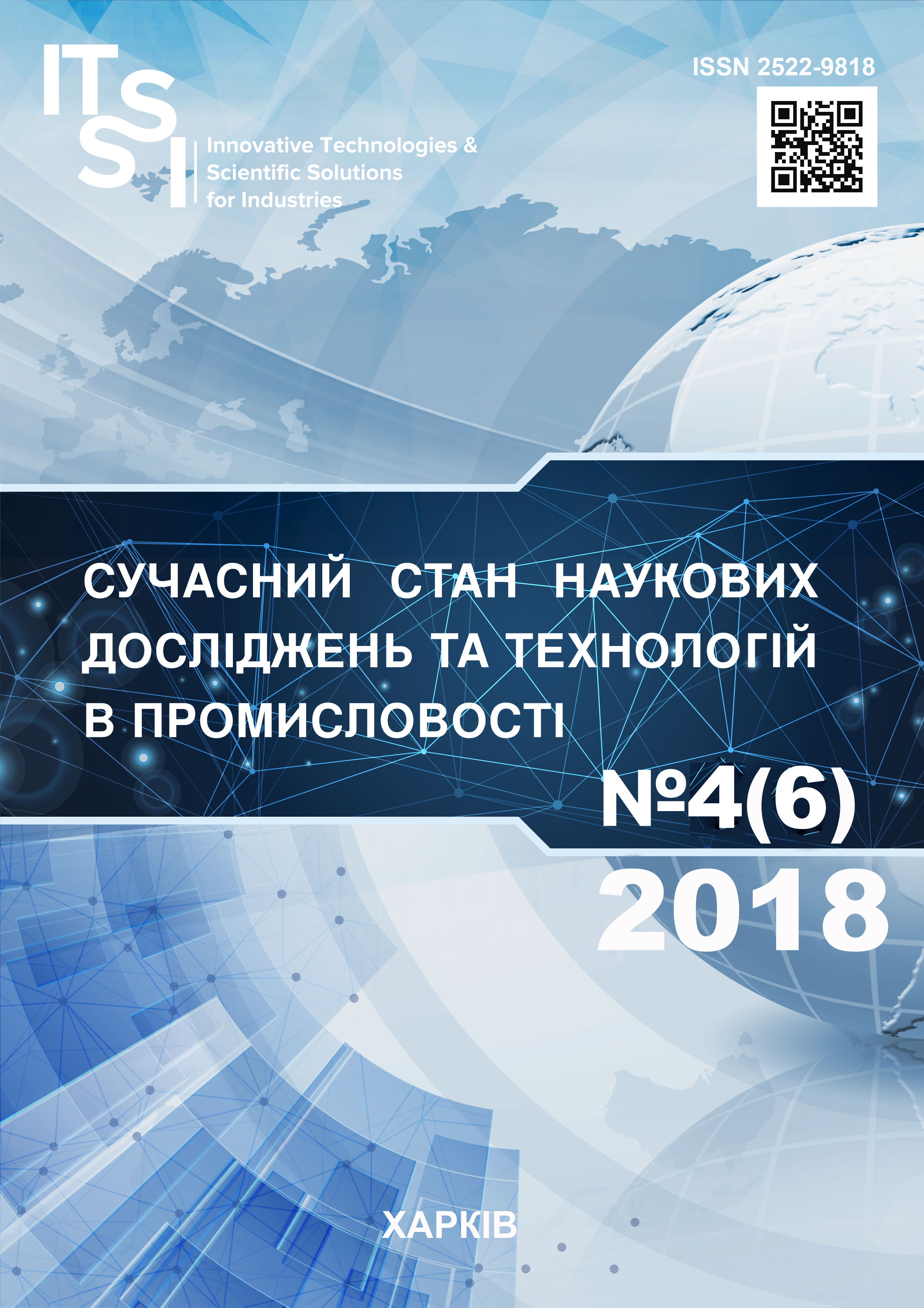МЕТОДИ ДІАГНОСТИКИ ВІДМОВ ТАНТАЛОВИХ ОКСИДНО-НАПІВПРОВІДНИКОВИХ КОНДЕНСАТОРІВ З ТВЕРДИМ ДІЕЛЕКТРИКОМ
DOI:
https://doi.org/10.30837/2522-9818.2018.6.057Ключові слова:
оксидно-напівпровідниковий конденсатор, метод моделювання, аналіз відмовАнотація
Предметом дослідження є оксидно-напівпровідникові конденсатори, які широко застосовуються у виробництві радіоелектронної апаратури. Метою дослідження є з'ясування основних причин відмов оксидно-напівпровідникових конденсаторів на стадії виробництва і в експлуатації. З цією метою побудовані аналоги плоских плівкових конденсаторів, які представляли різні виробничі і експлуатаційні ситуації (включаючи діелектричний пробій); були виявлені структури окремих шарів конденсаторів, їх хімічні та фазові формули і електричні властивості. Оскільки конденсаторні аноди мають пористу структуру і не піддаються звичайним методам дослідження плоских об'єктів, ми використовували метод моделювання. Моделюються дані порівнювалися з відповідними значеннями, виміряними на конденсаторах, які не спрацьовували при роботі або тестуванні. У процесі дослідження вирішено такі завдання: розглянуті фізичні явища, що відбуваються в конденсаторах при впливі різних факторів, що з'являються в процесі виробництва. Показано, що окислювально-відновні процеси призводять до погіршення стану конденсаторів. Встановлено, що основні причини деградації конденсаторів мають термодинамічний характер і вони зменшують час життя конденсаторів. Розроблено технологічні операції, які значно зменшують або виключають розглянуті види відмов. До них відносяться основні операції технологічного процесу. Легування анодів конденсаторів азотом. Ця операція виконується одночасно зі спіканням пористих анодів і сприяє підвищенню часу життя, робочих температур і зворотної напруги конденсаторів. Вирощування багатошарового діелектрика шляхом циклічної зміни формули електроліту, де відбувається анодування. Формування щільного катода шляхом застосування альтернативного електричного поля при просочуванні пористих анодів. Просочування органічним кремнієм секцій конденсаторів. При цьому створюється щільна водонепроникна плівка, яка блокує ділянки вільного діелектричного контакту з діоксидом марганцю і забезпечує хороше зчеплення захисної органічної плівки з секцією. У роботі використані методи: зондування електронним пучком, оже-спектроскопія і мікрозондового вимірювання.Посилання
Landsberge, L. M., Ghayou, R., Sayedi, M. et al. (1982), MOS (Metal Oxide Semiconductor), Physics and Technologies, New Jersey, 906 р.
Belenky, B., Gorbunov, N. (2008), "Tantalum capacitors - problems and prospects" ["Tantalovyye kondensatory – problemy i perspektivy"], Electronics. Science, technology, business, Issue : Element base of electronics.
Compal, Т. "Tantalum capacitors: application features", available at : https://www.compel.ru/lib/articles/tantalovyie-kondensatoryi-osobennosti-primeneniya (last accessed 12.10.2018).
"Oxide-semiconductor capacitors: types and advantages" ["Kondensatory oksidno-poluprovodnikovyye: vidy i dostoinstva"], available at : https://www.lectramist.com/oksidno-poluprovodnikovye-kondensatory-tipy-preimushchestva (last accesed 12.10.2018).
Jaekun, K., Hyunggjin, Yu., Woonghee, H. (2006), "A study on the characteristics of solid capasitor according to the pyrolysis methods", Korean. Chem. Eng. Res., Vol. 44, No.6, P. 614–622.
Fritzler, T., Azarian, M. H., Pecht, M. G. ( 2014), " Scintillation Conditioning of Tantalum Capacitors With Manganese Dioxide Cathodes", IEEE Transactions on Device and Materials Reliability, Vol. 14 (2), P. 630–638. DOI: 10.1109/TDMR.2014.2314731.
Franco, F. Di. et al. (2012), "Characterization of the Solid State Properties of Anodic Oxides on Magnetron Sputtered Ta, Nb and Ta–Nb Alloys", Journal of the Electrochemical Society, Vol. 159 (1), P. 33–39.
Moon, B. K. (1999), "Insulating properties of tantalum pentoxide capacitor films obtained by annealing in dry ozone", Journal of Applied Physics, No. 85, P. 1731.
Gurin, V. N. (2009), "Studying the chemical composition of Nb and Ta with dissolved oxygen", ["Izucheniye khimicheskogo sostava Nb i Ta s rastvorennym kislorodom"], Bulletin of the International Slavic University. Series: "Technical Sciences", Vol. XII, No. 1, P. 68-71.
Boyko, B. T., Panchekha, P. A., Pozdeev, Yu. L. et al. (1990), "The effect of nitriding on the structure of bulk-porous tantalum", ["Vliyaniye azotirovaniya na strukturu ob'yemo-poristogo tantala"], Physics and Chemistry of Materials Processing, No. 31,
P. 84–89.
"Reliability Handbook – Toshiba Memory Corporation", available at : https://business.toshiba-memory.com/content/dam/.../reliability-handbook-tmc- en.pdf (last accessed 12.10.2018).
Gorodisckij, A. V., Yakubtcov, O. A., Gurin, V. N. et al. (1991) "Auger Spectroscopy Stady of Nb – Nb2O5 –MnO2 System", 12-th Europeen Conference on Surface Scince, abstracts, Stokholm, Sweden, September, Vol. 15F, Р. 512.
Morozenko, E. S., Mazurenko, T. M., Yakubtcov, O. A. et al. (1992) "Auger Spectroscopy Stady of the Phase Interface in the System Nb2O5 – MnO2", Pitcon’92 Pittsburgh Conference, New-Orleans.
Jiang, Lu, Yue, Kuo, Jun-Yen, Tewg (2006) "Hafnium – Doped Tantalum Oxide High-k Gate Dielectrics", Journal of the Electrochemical Society, Vol. 153 (5), P. 410.
Morozеnko, E. S., Mazurenko, T. M., Yakubtcov, O. A., et al. (1993) "Auger Spectroscopy Stady of the MnO2 – Nb2O5 system modified by hot implantation of indium", J. Applied Surfact Science, No. 68, P. 491–495.
##submission.downloads##
Опубліковано
Як цитувати
Номер
Розділ
Ліцензія
Авторське право (c) 2018 Igor Nevliudov, Valeriy Gurin, Dmytro Gurin

Ця робота ліцензується відповідно до Creative Commons Attribution-NonCommercial-ShareAlike 4.0 International License.
Наше видання використовує положення про авторські права Creative Commons для журналів відкритого доступу.
Автори, які публікуються у цьому журналі, погоджуються з наступними умовами:
Автори залишають за собою право на авторство своєї роботи та передають журналу право першої публікації цієї роботи на умовах ліцензії Creative Commons Attribution-NonCommercial-ShareAlike 4.0 International License (CC BY-NC-SA 4.0), котра дозволяє іншим особам вільно розповсюджувати опубліковану роботу з обов'язковим посиланням на авторів оригінальної роботи та першу публікацію роботи у цьому журналі.
Автори мають право укладати самостійні додаткові угоди щодо не комерційного та не ексклюзивного розповсюдження роботи у тому вигляді, в якому вона була опублікована цим журналом (наприклад, розміщувати роботу в електронному сховищі установи або публікувати у складі монографії), за умови збереження посилання на першу публікацію роботи у цьому журналі.
Політика журналу дозволяє і заохочує розміщення авторами в мережі Інтернет (наприклад, у сховищах установ або на особистих веб-сайтах) рукопису опублікованої роботи, оскільки це сприяє виникненню продуктивної наукової дискусії та позитивно позначається на оперативності та динаміці цитування опублікованої роботи.














